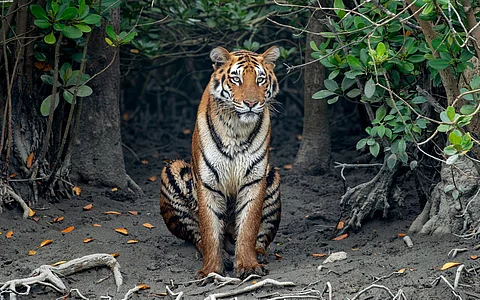

In the Sundarbans, tigers are notorious for attacking and consuming humans, a behavior not seen in other regions.
Experts suggest environmental factors like brackish water and low prey density may contribute to this anomaly.
Despite the fearsome reputation, not all Sundarbans tigers are man-eaters, and the actual number of human fatalities is much lower than perceived.
This is the fourth of a 5-part series. Read the first, second, third and fifth parts
Since time immemorial, tigers, the largest cats on Earth, have hunted and eaten humans. While tiger experts have successfully shown that humans are not tigers’ natural prey and most would leave people alone, there is one place on earth where this hypothesis almost turns upside down: the Sundarbans.
The world’s largest delta located in the Bengal region that is today divided between India and Bangladesh, tigers in the Sundarbans are (in)famous due to their predatory attacks on people. Not just hunting, the cats also are known to consume the bodies of people they have hunted.
These attacks have been documented not just in the modern day but also in times past.
Francois Bernier, among the most famous European travelers to India, gives us an account of these predatory attacks during the reign of Aurangzeb, the last Great Mughal.
“In traversing the Ganges in small rowing boats, the usual mode of conveyance among these islands, it is in many places dangerous to land, and great care must be had that the boat, which during the night is fastened to a tree, be kept at some distance from the shore, for it constantly happens that some person or another falls a prey to tigers. These ferocious animals are very apt, it is said, to enter into the boat itself, while the people are asleep, and to carry away some victim, who, if we are to believe the boatmen of the country, generally happens to be the stoutest and fattest of the party,” Bernier writes in a chapter titled ‘Of the kingdom of Bengale’, a part of his Travels in the Mogul Empire, A.D. 1656-1668.
In 1975, German biologist Hubert Hendrichs famously blamed the Sundarbans’ brackish water for its tigers taking to mankilling and maneating.
“Hendrichs (1975) had concluded that the primary reason for tigers in the Sundarbans killing high numbers of people (around 30 officially, but around 100 in each part of the Sundarbans) was the increased brackishness of the rivers. He concluded that this transformation had forced Sundarbans tigers to depend on the “sweetness” of human blood to obtain a certain dietary balance (1975). This was why, it was generally argued, contrary to tigers elsewhere, that the tigers attack humans only when they are old and impaired, young tigers of the Sundarbans were seeking out humans by swimming over to villages or lifting people off boats to satisfy their hunger,” Jayanta Kumar Mallick of the West Bengal forest department noted in his 2013 paper, Ecology, Status and Aberrant Behaviour of Bengal Tiger in the Indian Sundarbans.
Mallick also cited Kalyan Chakrabarti, who also worked in the Sundarbans as part of the forest department. In 1984, Chakrabarti wrote that he believed the ferocity of the tigers in the Sundarbans was related to the salinity of the surrounding water.
“Chakrabarti (1992) believes that salinity of water is probably the most important factor responsible for a good percentage of tigers turning man-eaters. Continuous consumption of salt water might have affected the kidneys and liver of the animals and, hence, changed their physiology (Chakrabarti, 1987). Thus, they lose their temperament and become maneaters,” writes Mallick.
He adds that this is an unproven hypothesis as no kidney ailment was discovered in any dead or rescued Sundarbans tiger.
It has also been believed that tigers in the Sundarbans developed a taste for human flesh as human corpses floating down the Ganga made their way to the delta, becoming easily available to the cats.
For Mallik, the tiger attacks and hunting and consumption of humans by them “is perhaps due to combined effect of environmental attributes and human activity pattern”.
“The saline water, muddy terrain, recurrent high tide, dense vegetation, etc, coupled with difficulty in preying upon animals bring about a psychological change in the tiger behaviour. This type leads to be cyclic and chronic giving the tiger predatory proficiency,” he says.
“It is not true that every tiger in the Sundarbans is a man-eater,” he concludes.
Experts whom Down To Earth (DTE) spoke to seemed to agree.
Krishnendu Basak, Human Wildlife Conflict Mitigation expert, says that low wild prey density in the Sundarbans, combined with frequent human presence in the forest may have increased encounters, gradually eroding tigers’ fear of humans. In some cases, this has led some individual tigers to see humans as potential prey.
Ullas Karanth, conservation biologist and tiger expert, argues that if we were to assume that all tigers were man-eaters needing 50 humans annually, the numbers would be alarming. “For example, in the Indian part of the Sundarbans, there are an estimated 101 tigers (according to the 2022 Tiger Estimation Report). If each tiger killed 50 humans per year, that would total 5,050 human fatalities annually. However, the actual average number of human deaths caused by tigers in the Sundarbans is only about 22 to 23 per year — just 0.43 per cent of the projected figure,” he told DTE.
Clearly, the relationship between tigers and humans in the Sundarbans is a complex one and is today part of myth and lore. An entire syncretic faith system prevails in the delta, one which combines Hindu and Islamic practices and forest deities like Dakshin Rai, Narayani Maa, Banabibi, Kalu Khan, Sa Jungli and Gazi Sahib. All this, based on the fear of tooth and claw.